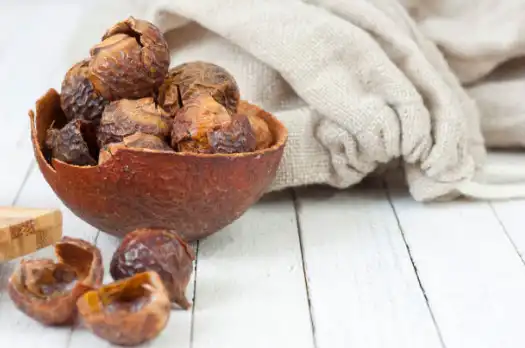Sapindus saponins are naturally occurring compounds found in various plant species, particularly in the Sapindus genus, commonly known as soapberries or soapnuts. These saponins have gained attention due to their potential health benefits and industrial applications. While Sapindus saponins are not typically found in common food sources, they are present in certain plants and fruits that have been used in traditional medicine and as natural cleaning agents. In this blog post, we'll explore the sources of Sapindus saponins and their potential uses.

What are the health benefits of Sapindus saponins?
Sapindus saponins have been the subject of numerous studies investigating their potential health benefits. These naturally occurring compounds have shown promising results in various areas of health and wellness. Here are some of the potential health benefits associated with Sapindus saponins:
- Anti-inflammatory properties: Research has shown that Sapindus saponins possess anti-inflammatory effects, which may help reduce inflammation in the body. This property could be beneficial for individuals suffering from chronic inflammatory conditions.
- Antimicrobial activity: Sapindus saponins have demonstrated antimicrobial properties against various bacteria, fungi, and viruses. This characteristic makes them potentially useful in natural antimicrobial products and treatments.
- Antioxidant effects: Studies have indicated that Sapindus saponins exhibit antioxidant properties, which can help protect cells from oxidative stress and damage caused by free radicals.
- Cholesterol-lowering potential: Some research suggests that Sapindus saponins may help lower cholesterol levels by interfering with cholesterol absorption in the intestines.
- Anticancer properties: Preliminary studies have shown that certain Sapindus saponins may have anticancer effects, inhibiting the growth and proliferation of cancer cells in laboratory settings.
- Skin health: Due to their gentle cleansing properties, Sapindus saponins are sometimes used in natural skincare products to help remove impurities without harsh chemicals.
- Digestive health: Some traditional medicine systems have used Sapindus-derived products to support digestive health, although more research is needed to confirm these effects.
It's important to note that while these potential benefits are promising, many of the studies have been conducted in laboratory settings or on animal models. More extensive human clinical trials are needed to fully understand the health benefits of Sapindus saponins and their practical applications in healthcare and wellness products.
How are Sapindus saponins used in traditional medicine?
Sapindus saponins have a long history of use in traditional medicine systems across various cultures, particularly in regions where Sapindus species are native. These natural compounds have been utilized for their medicinal properties and cleansing abilities. Here's an overview of how Sapindus saponins have been used in traditional medicine:
1. Ayurvedic medicine: In Ayurveda, the traditional medicine system of India, Sapindus mukorossi (soapnut) has been used for centuries. The fruit is known as "Reetha" and is believed to have various therapeutic properties:
- Skin conditions: Used to treat eczema, psoriasis, and other skin disorders
- Hair care: Believed to promote hair growth and treat dandruff
- Dental health: Used as a natural toothache remedy
- Digestive aid: Thought to help with indigestion and constipation
2. Traditional Chinese Medicine (TCM): In TCM, Sapindus species have been used for their medicinal properties:
- Expectorant: Used to treat coughs and clear phlegm
- Anti-inflammatory: Applied to reduce swelling and inflammation
- Detoxification: Believed to help cleanse the body of toxins
3. Native American medicine: Some Native American tribes have used Sapindus species for medicinal purposes:
- Rheumatism treatment: Applied topically to relieve joint pain
- Skin ailments: Used to treat various skin conditions
4. African traditional medicine: In parts of Africa, Sapindus species have been used in folk medicine:
- Fever reduction: Believed to help lower body temperature
- Pain relief: Used to alleviate various types of pain
It's important to note that while these traditional uses are fascinating and have been practiced for generations, many of them lack robust scientific evidence to support their efficacy. Modern research is ongoing to investigate the potential medical applications of Sapindus saponins and to validate some of these traditional uses.
The use of Sapindus saponins in traditional medicine highlights the importance of natural compounds in historical healthcare practices. As scientific research continues, we may gain a better understanding of how these traditional uses align with modern medical knowledge and potentially discover new applications for Sapindus saponins in contemporary healthcare.
Can Sapindus saponins be used as natural cleaning agents?
Sapindus saponins have gained significant attention as natural cleaning agents due to their unique properties. These compounds, found primarily in the fruit of Sapindus species (soapberries), have been used for centuries as a natural alternative to synthetic detergents. Here's an in-depth look at how Sapindus saponins can be used as effective and eco-friendly cleaning agents:
1. Surfactant properties: Sapindus saponins are natural surfactants, meaning they can reduce the surface tension of water. This property allows them to:
- Emulsify oils and fats, making them easier to remove from surfaces
- Penetrate and lift dirt and grime from various materials
- Create a foaming action that aids in cleaning
2. Laundry applications: Soapnuts or soapberries containing Sapindus saponins can be used as a natural laundry detergent:
- Gentle on fabrics, making them ideal for delicate clothing
- Effective in both cold and hot water
- Naturally softening, reducing the need for fabric softeners
- Hypoallergenic, suitable for people with sensitive skin or allergies
3. All-purpose cleaning: Sapindus saponins can be used to create all-purpose cleaning solutions for:
- Kitchen counters and appliances
- Bathroom fixtures and tiles
- Windows and mirrors
- Hardwood and tile floors
4. Personal care products: The gentle cleansing properties of Sapindus saponins make them suitable for use in:
- Natural shampoos and body washes
- Facial cleansers
- Hand soaps
5. Environmentally friendly: Using Sapindus saponins as cleaning agents offers several environmental benefits:
- Biodegradable and non-toxic to aquatic life
- Renewable resource, as soapberry trees can be sustainably harvested
- Reduced reliance on petroleum-based cleaning products
- Minimal processing required, reducing energy consumption in production
6. Cost-effective: While the initial cost of soapnuts may be higher than conventional detergents, they can be more economical in the long run:
- Reusable for multiple washes (in laundry applications)
- Concentrated form requires less product per use
- Multifunctional, reducing the need for multiple cleaning products
To use Sapindus saponins as cleaning agents, one can either purchase commercial products containing these compounds or use whole soapnuts directly. For laundry, placing a few soapnuts in a small cloth bag and adding it to the wash cycle can effectively clean clothes. For general cleaning, soapnuts can be boiled to extract the saponins, creating a concentrated liquid that can be diluted for various cleaning purposes.
Conclusion
While Sapindus saponins offer many advantages as natural cleaning agents, it's important to note that they may not be as strong as some synthetic detergents for heavily soiled items. Additionally, they may not produce the same level of fragrance as conventional cleaning products, which some users may miss. However, for those seeking a natural, eco-friendly alternative to traditional cleaning products, Sapindus saponins provide an effective and versatile option.
If you are also interested in this product and want to know more product details, or want to know about other related products, please feel free to contact lea_slsbio@163.com,WhatsApp+86 13193326505.

References
1. Sharma, A., Sati, S. C., Sati, O. P., Sati, M. D., & Kothiyal, S. K. (2011). Chemical constituents and bioactivities of genus Sapindus. International Journal of Research in Ayurveda and Pharmacy, 2(2), 403-409.
2. Goyal, S., Kumar, D., Menaria, G., & Singla, S. (2014). Medicinal plants of the genus Sapindus (Sapindaceae) - a review of their botany, phytochemistry, biological activity and traditional uses. Journal of Drug Delivery and Therapeutics, 4(5), 7-20.
3. Upadhyay, A., & Singh, D. K. (2012). Pharmacological effects of Sapindus mukorossi. Revista do Instituto de Medicina Tropical de São Paulo, 54(5), 273-280.
4. Chen, Y. F., Yang, C. H., Chang, M. S., Ciou, Y. P., & Huang, Y. C. (2010). Foam properties and detergent abilities of the saponins from Camellia oleifera. International Journal of Molecular Sciences, 11(11), 4417-4425.
5. Saxena, D., Pal, R., Dwivedi, A. K., & Singh, S. (2004). Characterization of sapindosides in Sapindus mukorossi saponin (reetha saponin) and quantitative determination of sapindoside B. Journal of Scientific and Industrial Research, 63, 181-186.
6. Kasai, R., Fujino, H., Kuzuki, T., Wong, W. H., Goto, C., Yata, N., ... & Tanaka, O. (1986). Acyclic sesquiterpene oligoglycosides from pericarps of Sapindus mukurossi. Phytochemistry, 25(4), 871-876.
7. Huang, H. C., Liao, S. C., Chang, F. R., Kuo, Y. H., & Wu, Y. C. (2003). Molluscicidal saponins from Sapindus mukorossi, inhibitory agents of golden apple snails, Pomacea canaliculata. Journal of Agricultural and Food Chemistry, 51(17), 4916-4919.
8. Ibrahim, M., Khan, A. A., Tiwari, S. K., Habeeb, M. A., Khaja, M. N., & Habibullah, C. M. (2006). Antimicrobial activity of Sapindus mukorossi and Rheum emodi extracts against H pylori: In vitro and in vivo studies. World Journal of Gastroenterology, 12(44), 7136.
9. Takagi, K., Park, E. H., & Kato, H. (1980). Anti-inflammatory activities of hederagenin and crude saponin isolated from Sapindus mukorossi Gaertn. Chemical and Pharmaceutical Bulletin, 28(4), 1183-1188.
10. Arulmozhi, D. K., Veeranjaneyulu, A., Bodhankar, S. L., & Arora, S. K. (2005). Pharmacological investigations of Sapindus trifoliatus in various in vitro and in vivo models of inflammation. Indian Journal of Pharmacology, 37(2), 96.

